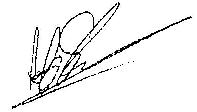Dept. of the Environment, Transport and the Reg Air Accidents Investigation Branch
Air Accidents Investigation Branch
DERA Farnborough
Hants GU 14 6TD
Telephone +44 1252 510300
FACSIMILE COVER LETTER
TO FAX NUMBER:. 00 356 249280
For the Attention of: Louis Giordimaina. Chief Engineer Air Malta
FROM: Peter Shepperd DATE: 8 March 1999
Accident To Piper Archer 9H-ABU
Please find attached our summary report of the examination of the Djerba ATC copy tape from the above accident. I apologise for it having taken so long. Could you let me know if you want the tape retumecl to you, or if you would l like to come over to discuss the analysis.
A Mrs. Boomer, who is the widow of one of the passengers and who I understand you know, has contacted me. She was asking if we could let her know in writing that AAIB were examining the copy tape. I indicated that I would have to refer to you in this matter. Could you let me know if there are any objections to this. I suspect that you would prefer to contact her yourself
Regards

Peter Sheppard
Assistant Principal Inspector Of Air Accidents
Head of Flight Recorder Section
ACCIDENT TO PIPER LANCE 9H-ABU. EN-ROUTE FROM DJERBA TO MALTA ON 3 DECEMBER 1995
EXAMINATION OF ATC TAPE COPY
Summary Report on AAIB Assistance to the Maltese Official Investigation
Prepared By

Peter F. Sheppard
Assistant Principal Inspector of Air Accidents
Head Of Flight Recorded Section
1. INTRODUCTION
On 3 December 1995 a Piper Lance was on a flight from Dierba to Malta with 5 passengers and 1 crew on board when it disappeared whilst over the Mediterranean sea. There were severe thunderstorms in the area at the time. It wasn’t until 2 months later that that some wreckage from the aircraft was brought to the surface by a fishing vessel.
In December 1998 the Maltese investigating authority requested AAIB to examine a copy ofthe Djerba Air Traffic Control (ATC) recordings of frequency 118.15MHz.
2. ATC COPY RECORDING
The ATC copy recording was contained on a standard C60 audio cassette with no time injection recordings. A copy of a the transcript produced by the Djerba authorities containing timing information was also handed over as a reference. There were some indications on the copy recording that may have been produced by means of a microphone positioned in front of a replay loudspeaker, which is not an ideal way to produce a re-recording. However, if this was the case there appeared to be little interference from background noise.
2.1 Timing
The transcript implied that the time period covered by the copy recording was approximately 33 minutes. However, the duration of recording on the cassette was only 15min 10sec. This and the fact that there was an unusual transient signal at the start of some of the recorded transmissions, would indicate that the original recording process was voice activated in some way.
2.2 Audio Examination
Each transmission from 9H-ABU was examined to determine if there were any unusual sounds or detectable frequencies associated with engine speed. There were no unusual noises on the transmissions apart from the transient signal at the start of some transmissions which appeared to be associated with some form of voice activation of the recording process.
The only frequencies which could be easily defined were multiples of 27Hz and a frequency of 180Hz, which were also present during the "quiet” periods between transmissions. They therefore cannot be associated with the aircraft. No frequencies which could be related to engine power were detectable.
The last transmissions from 9H-ABU were very broken with sometimes just the carrier wave being received. This could be an indication that the radio was at the limit of its range, operating under reduced power or shielded in some way. The second to last broken and unintelligible transmission was acknowledged by the controller with the words "Bravo uniform Roger you change with Malta". This gives the impression that he heard something that was not recorded. This can happen. as often ATC facilities are equipped with duplicated aeriels and receivers, and sometimes the recording is obtained from a different system to that in use by the controller. ln marginal conditions this can lead to one aerial not picking up something heard by the other.
When a microphone is keyed or unkeyed a unique transient "signature" can be generated on recordings. Such a signature was present at the end of the transmissions from 9H-ABU. Examination of the broken signals at the end of the recording also contained transients similar to this. It is therefore almost certain that these broken transmissions were from the accident aircraft.
ln the period from the transmission indicating that the aircraft was at 4000ft the tone of the pilots voice appeared to change slightly and the conversation from him appeared somewhat clipped. The frequency content of the voice was examined and over this period it appears to contain more high frequencies. This could be an indication of some degree of stress or anxiety.
